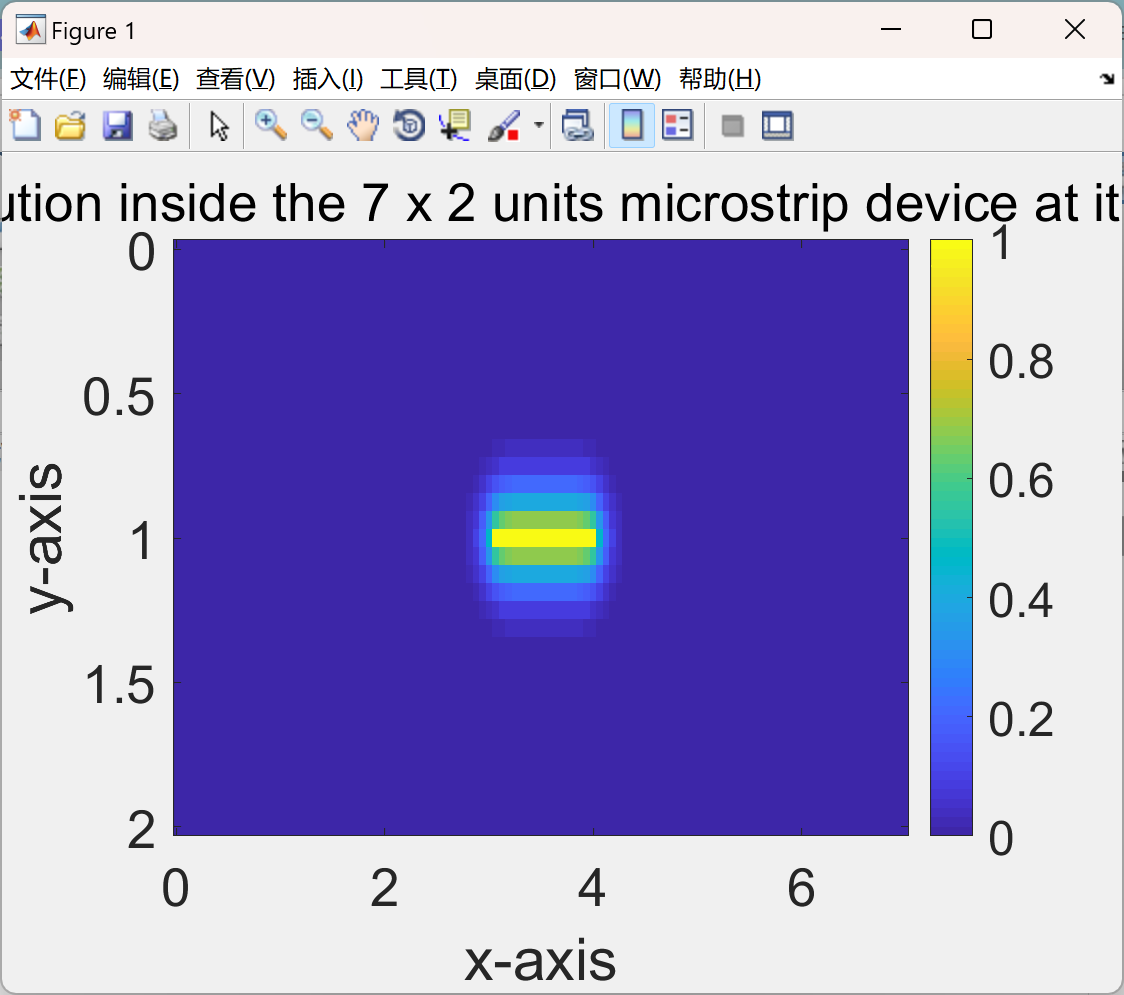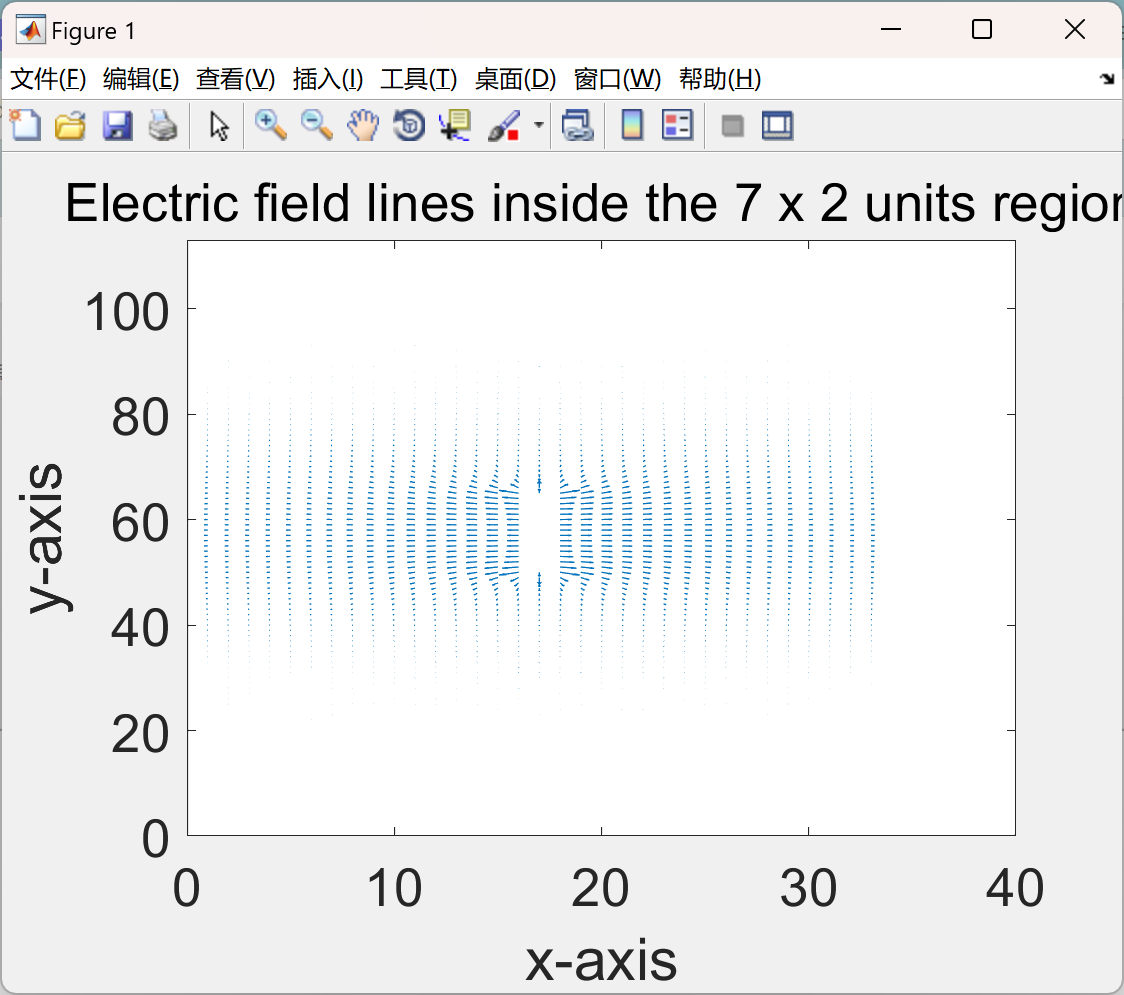💥💥💞💞 欢迎来到本博客 ❤️❤️💥💥
🏆 博主优势:🌞🌞🌞博客内容尽量做到思维缜密,逻辑清晰,为了方便读者。
⛳️ 座右铭:行百里者,半于九十。
📋📋📋 本文目录如下: 🎁🎁🎁
目录
💥1 概述
微带的有限元模拟是一种重要的分析方法。微带结构在现代电子技术中有着广泛的应用,如微波电路、天线等领域。有限元模拟通过将微带结构划分成有限个小单元,建立数学模型来近似求解其电磁场分布、传输特性等物理特性。在进行微带的有限元模拟时,首先需要根据微带的几何形状和材料属性建立合适的模型。然后,选择适当的边界条件和求解算法,对模型进行离散化处理。通过求解有限元方程,可以得到微带结构中各个节点处的电场、磁场强度等参数。有限元模拟可以帮助工程师深入了解微带的性能,优化设计参数,提高微带电路和天线的工作效率和可靠性。它可以预测微带的传输损耗、反射系数、辐射特性等,为实际的设计和制造提供重要的参考依据。同时,有限元模拟还可以进行参数化分析,研究不同参数变化对微带性能的影响,从而实现更加高效和精确的设计。
📚2 运行结果


主函数部分代码:
clear all;
clc;
%Dimensions of the simulation grid in x (xdim) and y (ydim) directions
xdim=7;
ydim=2;
%Area of square elements in the grid
area_sq_elem=0.0625^2;
%Step size in the grid in cartesian directions viz. side of the square
%element
step_size=area_sq_elem^0.5;
%No of square elements
sq_elems=(xdim*ydim)/area_sq_elem;
%Dimension in x direction in steps
dim1=xdim/step_size;
%Dimension in y direction in steps
dim2=ydim/step_size;
%No of triangular elements
no_of_elems=sq_elems*2;
%Total no of points for voltage distribution
total_no_pts=(dim1+1)*(dim2+1);
%grid_pts matrix consisting of numbering of all the points in the domain in
%a page read fashion from left to right and then top to bottom along with
%the x and y coordinates of the points in the adjacent columns of the
%matrix
grid_pts=zeros(total_no_pts,3);
%look_up_table matrix consisting of numbering of all the triangular
%elements in a page read fashion just like before along with the cardinal
%numbers of the three points making the triangular elements (obtained from
%the grid_pts matrix) in the adjacent columns of the matrix
look_up_table=zeros(no_of_elems,4);
%Populating the first columns of the above two matrices with serial numbers
i1=1:1:no_of_elems;
look_up_table(:,1)=i1';
i1=1:1:total_no_pts;
grid_pts(:,1)=i1';
% Polpulating the x coordinate and y coordinate columns of the grid_pts
% matrix with the appropriate values from the knowledge of the grid
% geometry
for i1=1:1:total_no_pts
if rem(i1,dim1+1)==0
grid_pts(i1,3)=((i1/(dim1+1))-1)*step_size;
else
grid_pts(i1,3)=(floor(i1/(dim1+1)))*step_size;
end
if rem(i1,dim1+1)==0
grid_pts(i1,2)=dim1*step_size;
else
grid_pts(i1,2)=(i1-(dim1+1)*floor(i1/(dim1+1))-1)*step_size;
end
end
% Polpulating the second, third and fourth columns of the look_up_table
% matrix with cardinal numbers (obtained from the grid_pts matrix) of three
% points forming the corresponding triangular element in the first column.
for i1=1:1:no_of_elems
k=ceil(i1/(2*dim1))-1;
if rem(i1,2)==1
look_up_table(i1,2)=(i1+1)/2+dim1+1+k;
look_up_table(i1,3)=(i1+1)/2+k;
look_up_table(i1,4)=(i1+1)/2+1+k;
else
look_up_table(i1,2)=i1/2+dim1+1+k;
look_up_table(i1,3)=i1/2+1+k;
look_up_table(i1,4)=i1/2+dim1+2+k;
end
end
% Area of all triangular elements are equal to half the area of all square
% elements as they are obtained by dividing the square elements by 2.
area_of_elem=area_sq_elem/2;
% Initializing and populating the P and Q matrices. P and Q matrices are
% defined for every element as P=(y2-y3,y3-y1,y1-y2) & Q=(x3-x2,x1-x3,x2-x1)
% where (x1,y1),(2,y2),(x3,y3) are the coordinates of the three points
% making up the triangular element starting from the bottom left point and
% moving anti-clockwise. Also, C matrices are iitialized for local eleements
% which is then accumulated into a global matrix
P=zeros(no_of_elems,3);
Q=zeros(no_of_elems,3);
C=zeros(no_of_elems,3,3);
for i1=1:1:no_of_elems
P(i1,1)=grid_pts(look_up_table(i1,3),3)-grid_pts(look_up_table(i1,4),3);
P(i1,2)=grid_pts(look_up_table(i1,4),3)-grid_pts(look_up_table(i1,2),3);
P(i1,3)=grid_pts(look_up_table(i1,2),3)-grid_pts(look_up_table(i1,3),3);
Q(i1,1)=grid_pts(look_up_table(i1,4),2)-grid_pts(look_up_table(i1,3),2);
Q(i1,2)=grid_pts(look_up_table(i1,2),2)-grid_pts(look_up_table(i1,4),2);
Q(i1,3)=grid_pts(look_up_table(i1,3),2)-grid_pts(look_up_table(i1,2),2);
for j=1:1:3
for k=1:1:3
C(i1,j,k)=(1/(4*area_of_elem))*(P(i1,j)*P(i1,k)+Q(i1,j)*Q(i1,k));
end
end
end
% Initializing matrix C_global from which propagation voltage distribution
% is calculated using iterative analysis
C_global=zeros(total_no_pts,total_no_pts);
% Calculating matrix C1_global by adding up local C matrices
for i=1:1:no_of_elems
for j=1:1:3
for k=1:1:3
C_global(look_up_table(i,j+1),look_up_table(i,k+1))=C_global(look_up_table(i,j+1),look_up_table(i,k+1))+C(i,j,k);
end
end
end
%Initializing previous (V_prev) voltage distribution matrix viz the voltage
%distribution matrix before any iteration
V_prev=zeros(dim1+1,dim2+1);
% Giving Dirichlet boundary cnditions for previous voltage distribution matrix
% at the plates and microstrip line
V_prev(1,1:dim2+1)=0;
V_prev(dim1+1,1:dim2+1)=0;
V_prev(1:dim1+1,1)=0;
V_prev(1:dim1+1,dim2+1)=0;
V_prev(3*(dim1/7)+2:4*(dim1/7)+1,(dim2/2)+1)=1;%Microstrip line
%Initializing present (V_now) voltage distribution matrix viz the voltage
%distribution matrix after any iteration and the matrix is given a critical
%difference from V_prev matrix at (2,2) to enter loop of update.
V_now=V_prev;
V_now(2,2)=1;
%Iteration counter iter initialized
iter=0;
%Update loop begins with condition as difference between two matrics being
%greater than 0.001
while(max(max(abs(V_prev-V_now)))>1e-3)
%Iteration counter incremented
iter=iter+1;
%Initial critical difference between matrices removed in first
%iteration
if iter==1
V_now(2,2)=0;
end
%Updating V_prev of present iteration with V_now of previous iteration
V_prev=V_now;
%Clearing V_now for update
V_now(:,:)=0;
%Updating V_now using standard update procedure obtained from FEM
%analysis
for k1=1:1:dim2+1
for k2=1:1:dim1+1
for i1=1:1:dim2+1
for i2=1:1:dim1+1
if(C_global((k1-1)*(dim1+1)+k2,(i1-1)*(dim1+1)+i2)>0 || C_global((k1-1)*(dim1+1)+k2,(i1-1)*(dim1+1)+i2)<0)
if(i1<k1 || i2<k2 || i1>k1 || i2>k2)
V_now(k2,k1)=V_now(k2,k1)-(1/C_global((k1-1)*(dim1+1)+k2,(k1-1)*(dim1+1)+k2))*V_prev(i2,i1)*C_global((k1-1)*(dim1+1)+k2,(i1-1)*(dim1+1)+i2);
end
end
end
end
end
end
% Giving Dirichlet boundary cnditions for previous voltage distribution matrix
% at the plates and microstrip line
V_now(1,1:dim2+1)=0;
V_now(dim1+1,1:dim2+1)=0;
V_now(1:dim1+1,1)=0;
V_now(1:dim1+1,dim2+1)=0;
V_now(3*(dim1/7)+2:4*(dim1/7)+1,(dim2/2)+1)=1;%Microstrip line
🎉3 参考文献
文章中一些内容引自网络,会注明出处或引用为参考文献,难免有未尽之处,如有不妥,请随时联系删除。
[1]杨黎.超长混凝土结构膨胀加强带有限元模拟与温度场分析[D].河北工程大学,2021.DOI:10.27104/d.cnki.ghbjy.2021.000769.
[2]张飞.有限元模拟在微带板焊接中应用研究[J].科技视界,2017,(08):46-47.DOI:10.19694/j.cnki.issn2095-2457.2017.08.024.
🌈4 Matlab代码实现





















 2536
2536

 被折叠的 条评论
为什么被折叠?
被折叠的 条评论
为什么被折叠?








